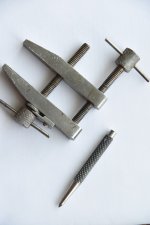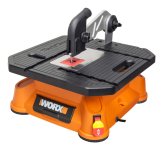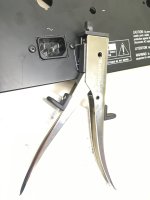Drilling metal isn't as hard as it looks! A hole that large will take some care, but if it's not perfect it will be hidden. I would:
- Use a decent drill bit, the cheap "titanium coated" bits will do but carbide are better.
- Use an awl and a hammer to make a small indent at the center of the whole. This crates a guide that will prevent the drill from skating
- Go slow
- Use a cutting oil. Any cheap oil like 3-in-1 or machine oil will work.
- It will grab the metal a bit as the hole finishes, be careful and go extra slow towards the end.
- If you have a friend with a drill press that will make this job very easy.
Eye protection too.A Dremel tool with a reinforced cutoff wheel can make reasonably quick work of slicing some lines through an 18ga steel chassis. A pair of hearing protectors may be a good idea though.
You can watch me make a rectangular cutout for an IEC inlet here:
Tom
I tried making an IEC adapter board using an expired card and it worked perfectly. 😀



Last edited:
I‘d consider a card to be not sturdy enough to withhold the torsion forces of plug/unplugging it much more than 2, 3 times until the card is gone.
A good option is to use a piece of standard FR-4 PCB material - plenty sturdy and can be machined/cut etc. easily. Blank material can be found very cheaply, especially from surplus vendors. Or, just order a custom PCB made to fit - very cheap to have done.
Two mounting screws secure the IEC socket to the rear panel, which withstands the torsion forces of plug/unplugging. The purpose of the adapter plate is to cover the gap at the top and bottom.I‘d consider a card to be not sturdy enough to withhold the torsion forces of plug/unplugging it much more than 2, 3 times until the card is gone.
I used plastic card just for experimentation and it took me 15 minutes to make, most of which was spent drawing the template.
I don't understand the opposition to just drilling a row of small holes along the outline and using a file to get the hole to the final shape. It takes maybe 10 minutes to do and yields professional results.
Tom
Then you might as well have the whole panel made by the PCB manufacturer. It's silly cheap, especially if you're willing to wait for a slower shipping option.Or, just order a custom PCB made to fit - very cheap to have done.
Tom
Or Protocase: https://www.protocase.com/

Note that the centre punch has a sharp point at the business end of it. Unlike a nail set which has a blunt point.
Tom
Don't wreck your awl. Use a centre punch to mark the centre of the holes.Use an awl and a hammer to make a small indent at the center of the whole.
Note that the centre punch has a sharp point at the business end of it. Unlike a nail set which has a blunt point.
Tom
Almost 50 years ago, part of my first year as an apprentice mould toolmaker was a week spent making a pair of toolmakers clamps out of mild steel. They were filed to shape and size purely by hand, there was no oil allowed anywhere near the files and the job.....I hear folks recommend lubricating oil when filing steel, should prolong the life of your tool.
Hello again!
I am doing some maintenance (and some upgrades) to my Mosvalve 500 power amp, and one of the things I'd like to address is the captive cable at the rear of the unit, obviously used to power it up. I was thinking of creating space for a standard IEC receptacle, but I don't know the best way of going about it, so I've decided to come here for help. I don't actually have a router, and I want to know how stupid an idea it would be to use HSS drill bits and a drill to get the shape most of the way there and just file out the rest.
Thanks in advance!
The answer to your question is "yes" you can do that, easily. Drill and file. Yes Yes Yes.
Need only a drill and and a couple files (round, flat). Maybe drill a large hole you expand with files or tiny holes around the edges you cut out with files.
Your choice.
I have done this many times.
Use a round "router" type file for most of the work, round cuts better and more than flat. Flat to finish.
If you have aluminum- no issues, go slow.
If you have steel- the filing action will make screeching banshee noises that cause you to go deaf!
Very loud but do not worry, still works. But very very loud.
You can do to a chassis with stuff in there just makes small localized dust so block nearby components with masking tape/ plastic.
Go slow, take 2 or 3 days...you will know why when you start.
Here is thick aluminum as an example with drill and files in background.
Last edited:
I have a table jigsaw similar to the one in the attached picture, and it works really well for making internal cuts. It uses standard jigsaw blades and the blade is supported at both ends so it tracks straight. With a metal cutting blade, it cuts aluminum plate or bar easily. Great for small items for which a big mitre saw is overkill, literally.
Attachments
For years I ignored the nibbler because you can't really tell from its looks how it works.
I never really believed it could work because it just did not make sense to me.
But with a demo video it looks like a sweet tool.
Nibbler video
I never really believed it could work because it just did not make sense to me.
But with a demo video it looks like a sweet tool.
Nibbler video
That's a neat idea. I've used a regular coping saw with a metal cutting blade. That works too. Mine isn't as nice as this one:I have a table jigsaw similar to the one in the attached picture
Tom
I drill six holes at each corner/bend in the IEC connector shape and use a fine bladed jigsaw to join the holes. Make a cardboard cutout template that fits the connector you are using as if it was actually mounted. Use the template to draw the exact outline of the hole. Saw and file until all the black marker lines are gone and you should have an exact fit. It gets easier the more times you do it. There is a lip on the IEC Jack that will hide the slight imperfections.
- Home
- Design & Build
- Construction Tips
- Routing out a hole for IEC connector


